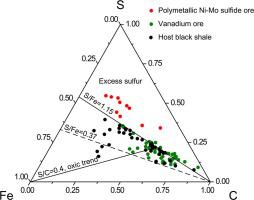Ore Geology Reviews ( IF 3.3 ) Pub Date : 2021-05-04 , DOI: 10.1016/j.oregeorev.2021.104210 Lingang Xu , Jingwen Mao

|
Early Cambrian black shales are widely exposed along the southeastern margin of the Yangtze Platform in South China for a length of over 1600 km. The basal part of this sequence host a large spectrum of mineralization, including polymetallic Ni-Mo sulfide, vanadium, phosphorite, barite, as well as combustible shale (stone coal). In particular, the polymetallic Ni-Mo sulfide ore layer is stratigraphically equivalent but geographically separated from the V mineralization. In the Zhangjiajie region in Hunan province, the tenor of the polymetallic Ni-Mo sulfide mineralization in the northeastern segment decreases gradually and grades into vanadium mineralization in the southwestern segment. Based on the stratigraphic correlation, we compared the trace element composition and carbon–sulfur-iron system of the polymetallic Ni-Mo sulfide ore, vanadium ore, and their host black shales.
The polymetallic Ni-Mo sulfide and V ores display similar PAAS-normalized REE distribution patterns with negative Ce and positive Y anomalies, similar to present-day seawater. The polymetallic sulfide ores show elevated seawater-like Y/Ho ratios (mean: 52.7 ± 6.8) and the V ores with an average Y/Ho ratio of 40.2 ± 3.8 reflect the influence of terrigenous material. Although both the polymetallic Ni-Mo sulfide ore and the V ore formed under anoxic conditions, the degree of oxygen deficiency was variable, i.e., euxinic condition for the polymetallic sulfide ore but euxinic and suboxic conditions for the vanadium ore. This model is supported by the more elevated redox-sensitive elements (e.g., U and Co) in the polymetallic Ni-Mo sulfide ores compared to the V ores. Excess sulfur of the polymetallic Ni-Mo sulfide ores with S/Fe ratios>1.15 suggests that they formed under iron-limited euxinic conditions. In contrast, the V ores formed under euxinic to suboxic conditions with S/Fe ratios close to or lower than 1.15. The host black shales display positive correlations for TOC and redox-sensitive elements, suggesting that they formed under suboxic conditions. We infer that the polymetallic Ni-Mo sulfide ores formed in a sediment-starved semi-restricted euxinic marine basin. In contrast, the V ores formed under both euxinic and intermittently suboxic to euxinic conditions at the slope of the basin with terrestrial input from enhanced continental weathering. Repeated transgressive–regressive episodes led to the formation of V ores interlayered with suboxic black shale with more subdued oxygen deficiency. The results of this study suggest that exploration for V mineralization should focus on the southeastward lateral stratigraphic equivalents of the polymetallic Ni-Mo sulfide mineralization.



























 京公网安备 11010802027423号
京公网安备 11010802027423号